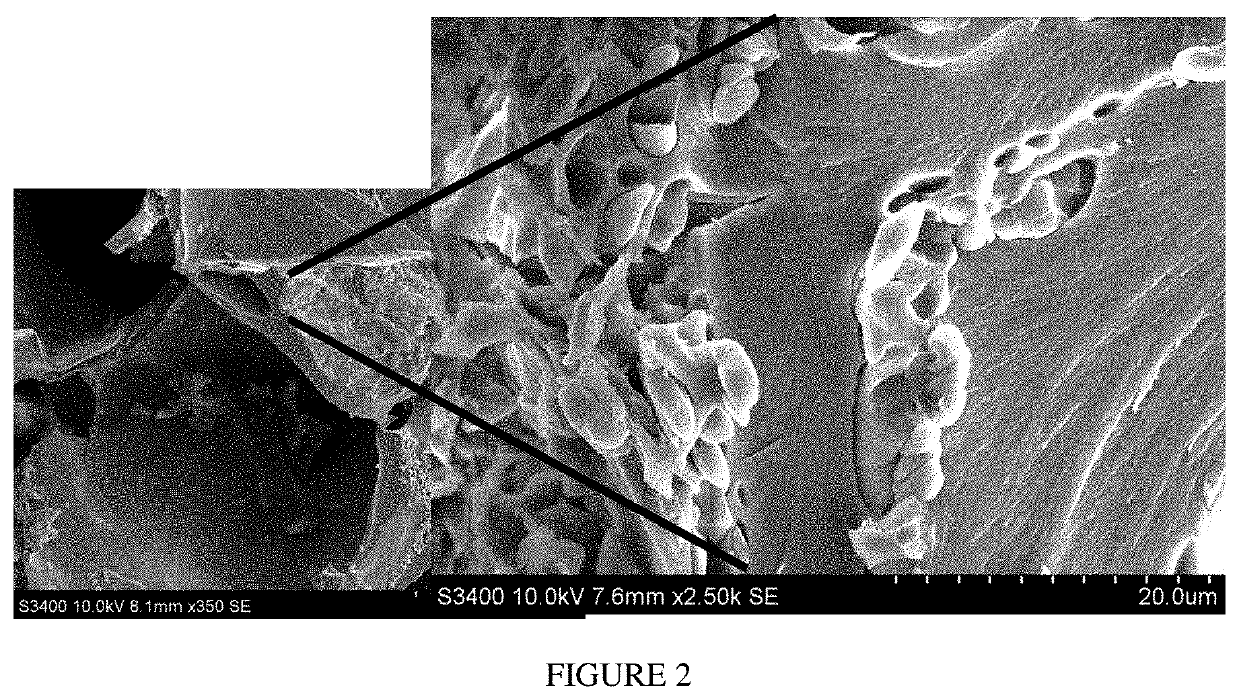Methods and compositions for achieving hemostasis and stable blood clot formation
a hemostasis and blood coagulation technology, applied in drug compositions, bandages, extracellular fluid disorders, etc., can solve the problems of significant morbidity, tissue sealants are not hemostats per se, and currently available approaches have limitations in effectiveness, safety, applicability and ease of use, etc., to achieve hemostasis more slowly, reduce major complications, and facilitate hemostasis rapid
- Summary
- Abstract
- Description
- Claims
- Application Information
AI Technical Summary
Benefits of technology
Problems solved by technology
Method used
Image
Examples
example 1
Method of Making an Exemplary Acrylated Chitosan Composition
[0377]This example describes a method for making an acrylated chitosan for use in creating a hemostatic hydrogel composition.
[0378]An exemplary acrylated chitosan was prepared as follows:
Step 1—Preparation of a Chitosan Intermediate
[0379]4.0 g of raw chitosan (Mw=162 kDa, PDI=2.3, DDA=79%) starting material was dissolved in 200 g of 1% (v / v) acetic acid solution for 30 minutes at 25° C. to produce a mixture. The mixture was then heated to 100° C. and held at this temperature for 2 hours.
Step 2—Preparation of the Acrylated Chitosan Intermediate
[0380]The mixture comprising the chitosan intermediate was then cooled to 50° C. Thereafter 5.3 g of acrylic acid was added and the mixture was then heated to 100° C. and held at this temperature for 60 minutes. The reaction was then cooled to 28° C. and then quenched by the addition of NaOH until a final pH value of 12.4 was achieved.
Step 3—Preparation of the Acrylated Chitosan Compos...
example 2
Method of Making an Exemplary Acrylated Chitosan Composition
[0383]This example describes another method for making an acrylated chitosan for use in creating a hemostatic hydrogel composition.
[0384]An exemplary acrylated chitosan was prepared as follows:
Step 1—Preparation of a Chitosan Intermediate
[0385]4.009 g of raw chitosan (Mw=251 kDa, PDI=3.41, DDA=87.87%) starting material was dissolved in 200 g of 1% acetic acid solution (v / v) for about 14 hours at 25° C. to produce a mixture. The mixture was then heated to 100° C. and held at this temperature for 2 hours.
Step 2—Preparation of the Acrylated Chitosan Intermediate
[0386]The mixture comprising the chitosan intermediate was then cooled to 50° C. Thereafter 5.4 g of acrylic acid was added and the mixture was then heated to 100° C. and held at this temperature for 60 minutes. The reaction was then cooled to 28° C. and then quenched by the addition of NaOH until a final pH value of 12.81 was achieved.
Step 3—Preparation of the acrylate...
example 3
Method of Making an Exemplary Acrylated Chitosan Composition
[0389]This example describes a third method for making an acrylated chitosan for use in creating a hemostatic hydrogel composition.
[0390]An exemplary acrylated chitosan was prepared as follows:
Step 1—Preparation of a Chitosan Intermediate
[0391]4.002 g of raw chitosan (Mw=170 kDa, PDI=1.91, DDA=84.67%) starting material was dissolved in 200 g of 1% acetic acid solution (v / v) for about 14 hours at 25° C. to produce a mixture. The mixture was then heated to 100° C. and held at this temperature for 2 hours.
Step 2—Preparation of the Acrylated Chitosan Intermediate
[0392]The mixture comprising the chitosan intermediate was then cooled to 50° C. Thereafter 5.4 g of acrylic acid was added and the mixture was then heated to 100° C. and held at this temperature for 35 minutes. The reaction was then cooled to 28° C. and then quenched by the addition of NaOH until a final pH value of 13.06 was achieved.
Step 3—Preparation of the Acrylate...
PUM
| Property | Measurement | Unit |
|---|---|---|
| Temperature | aaaaa | aaaaa |
| Temperature | aaaaa | aaaaa |
| Temperature | aaaaa | aaaaa |
Abstract
Description
Claims
Application Information
 Login to View More
Login to View More - R&D
- Intellectual Property
- Life Sciences
- Materials
- Tech Scout
- Unparalleled Data Quality
- Higher Quality Content
- 60% Fewer Hallucinations
Browse by: Latest US Patents, China's latest patents, Technical Efficacy Thesaurus, Application Domain, Technology Topic, Popular Technical Reports.
© 2025 PatSnap. All rights reserved.Legal|Privacy policy|Modern Slavery Act Transparency Statement|Sitemap|About US| Contact US: help@patsnap.com



